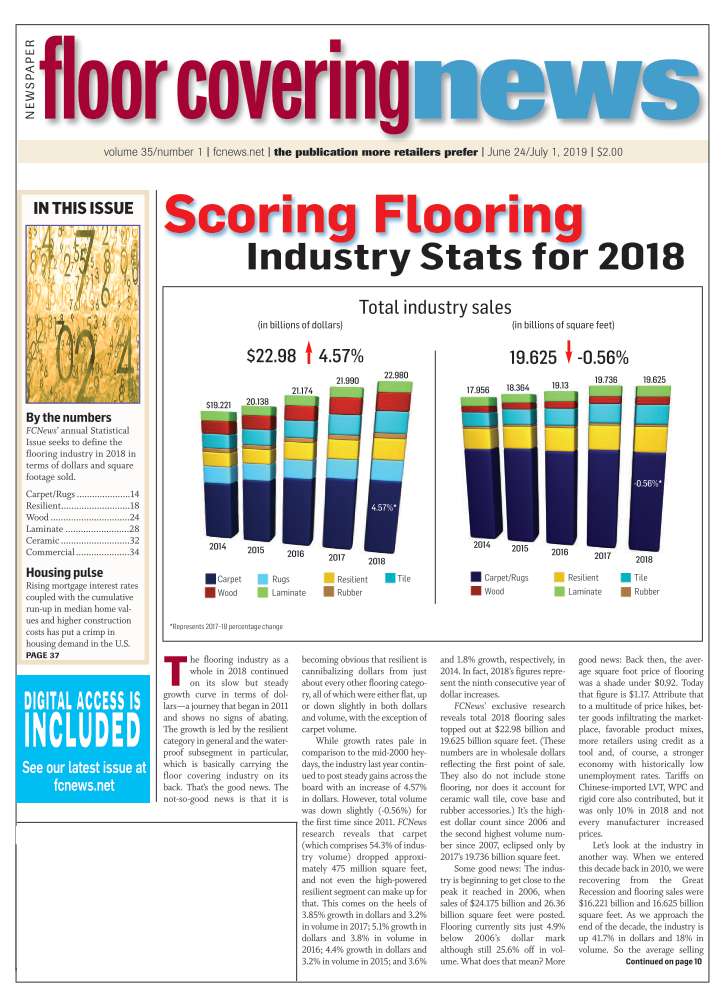June 24/July 1, 2019: Volume 35, Issue 1
By Steven Feldman
 The most arduous task of the year is now in the rear-view mirror. The FCNews team has been combing through industry statistics for months, making countless phone calls and trying to extrapolate data from annual reports. But at long last, the 2018 statistics are in the can. When the dust settled, FCNews pegged U.S. floor covering industry sales for 2018 to be a shade under $23 billion as well as 19.625 billion square feet, resulting in a gain of 4.57% in dollars and a 0.56% decline in volume. Interestingly, we saw a larger percentage gain in dollars than for 2017 but the first drop in volume in seven years. Carpet was the culprit.
The most arduous task of the year is now in the rear-view mirror. The FCNews team has been combing through industry statistics for months, making countless phone calls and trying to extrapolate data from annual reports. But at long last, the 2018 statistics are in the can. When the dust settled, FCNews pegged U.S. floor covering industry sales for 2018 to be a shade under $23 billion as well as 19.625 billion square feet, resulting in a gain of 4.57% in dollars and a 0.56% decline in volume. Interestingly, we saw a larger percentage gain in dollars than for 2017 but the first drop in volume in seven years. Carpet was the culprit.
Every year I like to remind our readers that these statistical reports are like… well, never mind. Let’s just say, everyone has one. While we are quite confident in our assessment of the industry, we know other reports will have different results for varied reasons. First, some reports contain sales of stone flooring. I have seen some reports that have pegged stone flooring to be around $1 billion. Stone includes marble, granite, travertine, slate, etc., which have uses beyond flooring. We could call stone suppliers and get their assessments, but that would be purely anecdotal.
Another part of the floor covering world not included in this report is polished concrete. My friend Curt Thompson, formerly of Wilsonart, is in that business today and argues that polished concrete is bigger than anyone in our industry wants to admit. If our commercial volume numbers are less than what you thought, polished concrete may be the culprit.
Now, when it comes to ceramic, that number may be larger in other reports. That’s because those may include wall tile. Today, so much of ceramic can be used interchangeably on the floor or wall. We have reached out to many industry insiders, and the feeling is floor tile represents about 75% of the total ceramic number, give or take. So that’s what we use.
Likewise, our rubber numbers include only tile and sheet flooring. Two years ago, we made the decision to eliminate cove base, accessories, stair treads, etc. We revised our numbers back five years to reflect this change. So, that $227.4 million encompasses what we seek to identify.
Other reports rely solely on government numbers, which requires massaging if you stress accuracy. For example, there isn’t anyone who believes the U.S. hardwood flooring market is over $3 billion. The government number for hardwood flooring includes things such as wood for tractor trailer beds and mislabeled engineered wood-based flooring products that use MDF or HDF as their primary cores.
Arguably the most difficult category to nail down accurately is resilient. There is so much that constitutes the segment: sheet, LVT and its subsegments WPC and rigid. You also have VCT and the inexpensive peel-and-stick tile.
FCNews has taken a unique approach these past few years. I personally call every manufacturer that does any appreciable business in the category with the promise of confidentiality. That’s what 25 years of not betraying anyone’s trust has earned.
This year posed some new challenges: first, trying to get a handle on imports and deciphering between WPC, rigid and straight LVT. Second, in a word, Armstrong. It’s like the “Iron Curtain” over there. Its annual report reveals as much as an Amish woman’s dress. Hey, here are our sales and we’re about 20% international and 40% residential/40% commercial. Well, first, a former employee in the know told me the business was 60% commercial. I know the VCT number. So, if you take the overall number, factor out the international business, give the company a 40/60 commercial split, factor out the VCT component, you wind up with about $230 million residential sheet and tile, and $130 million commercial sheet and tile. From there, the research boils down to assessing the sheet/tile split. Luckily, we don’t have to do that exercise too many times.
Are our numbers exact? No. Are they as good or better than anything out there? Yes. And for the record, WPC/rigid for 2018 was $1.6 billion residentially and another $150 million commercially. That’s where all the industry growth is coming from, in case you’ve been sleeping under a rock for a year. (Since I’m asked that question at least once a week.)
As for determining that “other” LVT/WPC/rigid number, this is the piece we estimate. There are a lot of companies doing between $2 million and $10 million in imported product; it would be impossible to talk to each and every one of them. But we think we have a good handle on what’s coming in.
Enjoy the report.

